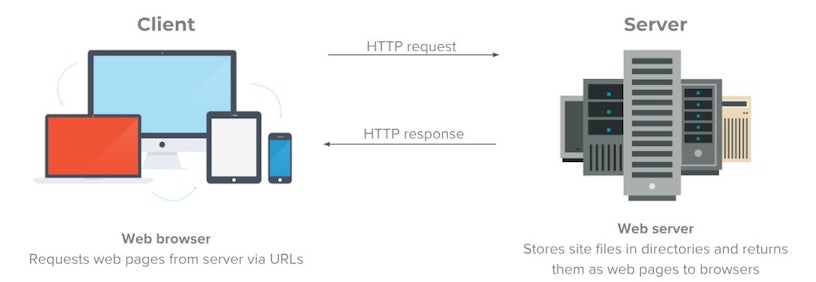Maybe you’ve seen those random three-digit codes when you’ve been on a website and always wondered what they mean. Or maybe you’re about to do your first technical audit of a site.
Whatever the case, it’s incredibly useful for digital marketers to know what status codes are and what the most common ones mean for websites. This is so that when problems arise on your site, you have a better understanding of why they’ve come about and how you can solve them.
What is a Status Code?
An HTTP (Hypertext Transfer Protocols) status code is a server response to a browser’s request. The status code gives you the “status” of the requested URL that you clicked on or searched. The first digit of each three-digit status code begins with one of five numbers, 1 through to 5.
Status codes can be compared to a conversation between your browser and the web server that stores site files and returns them as web pages to browsers. The browser request asks the server for a webpage, and the server can respond in a number of ways including:
- Whether or not the page exists
- If there is a problem with the webpage
- Or if there is a problem with the server itself.

Why are status codes important?
Ultimately, they are useful for SEOs to find opportunities to optimise websites. Status codes allow you to determine the status of yours or your clients’ sites and web pages. If you use them to redirect old web pages to new, better versions, status codes can increase user experience and steer customers in the right direction.
The main status codes you should be aware of
2XXs (Active Pages)
As a shopper or visitor, the likelihood of you seeing a 200 code on the shopper/visitor-facing side of a webpage is slim to none. This is because a 200 status code means the request was successfully completed and the server gave the expected response.
It’s the ideal status code for your properly functioning sites and web pages. Why? Because as a digital marketer, you now know visitors, bots, as well as link equity, are passing through the linked pages with no problem at all.
3XXs (Redirection)
300 status codes indicate that you have been redirected to another webpage. The most commonly used codes in this group are:
301
These are used when the requested URL has permanently moved to a new location. Digital marketers will often use 301 status codes to increase optimisation when they have moved a site or page to something new and improved. If they don’t, users and search engines will see a 404 error page (explained below) if they try to open the URL. By using a 301, it will also ensure that roughly 75% of the link value of the old URL will transfer to the new URL.
301 redirects would ideally be used on e-commerce product pages where the item is permanently out of stock or no longer carried by the supplier. The best practice here would be to redirect the visitor back to the category page.
302
These status codes are used when the requested URL has temporarily moved to a different location. Emphasis on the temporary – 302 redirects should only be used if you are sure that you will use the previous, same URL again. Since this code conveys to search engines that the URL will be used again, no link value is transferred over to the new URL. Because of this, it’s not recommended to use a 302 when moving your domain or making big changes to your site structure.
This would be used for an e-commerce product page where the item is out of stock temporarily out of stock. The best practice here would be to redirect the visitor back to the category page as a temporary solution until the URL is live again with the product back in stock.
4XXs (Client error)
The 400 group of status codes indicate an error on the client side of the website; meaning that the problem is coming from the web developer side. The internal nature of 400 status codes mean that they can be fixed internally in-house or by the outsourced digital marketing agency.
404
404 Not Found is the most common status code that most people will know, even those who don’t know what status codes are. They mean that the file or page that the browser is requesting wasn’t found by the server. Imagine the webpage is a file that the client had to give to the server to store. But perhaps the client forgot to send this or did something wrong which meant that the server couldn’t find it in its ‘filing cabinet’.
Digital marketers should take care to monitor what 404s are happening on their websites so they can 301 redirect a user to the appropriate content. Otherwise, visitors will hit a page with a 404 error and either try again or move on to your competitor’s site. If that’s not bad enough, having too many 404s can cause ranking issues in search engines due to lack of link equity passing.
410
This status code means that the page has been specifically removed. 410 status codes should be used when a resource has been intentionally removed and that it should be purged from search engine results. They can be particularly helpful if yours or your clients’ site comes under attack from hackers or wants to remove any controversial content.
You should be careful when using this status code and it should never be the default behaviour.
5XXs (Server error)
As seen in the above image, codes of the 500 group indicate that there is an issue with the server. The most common ones are:
500
Instead of the problem being that the page is missing or cannot be found, a 500 status code indicates that there is a problem with the server. This is a classic server error that is hated by users and developers because it means something has gone wrong at a database level.
If your website is returning 500 errors, they need to be addressed asap. Traffic from visitors and bots alike will be lost, and link value will drop rapidly.
503
A 503 response means that the server is unavailable as the server is currently unable to handle the request due to an outage or overload. This status code indicates that the server is either unavailable, overloaded or currently under maintenance.
503 status codes can appear when Black Friday sales are occurring on websites and there are too many visitors, therefore too many requests, to the server. This code could be pre-emptively avoided by expanding the server bandwidth or increasing server capacity before peak activity.
Summary
There are so many status codes out there that it would be hard for most digital marketers to keep track of. However, these are the most common status codes that beginners should be aware of. By having an understanding of these, you can understand the root of any problems that might arise on your site. Equally, knowing status codes means you can rest assured in the knowledge of when your site is healthy and doing what it is supposed to do.



